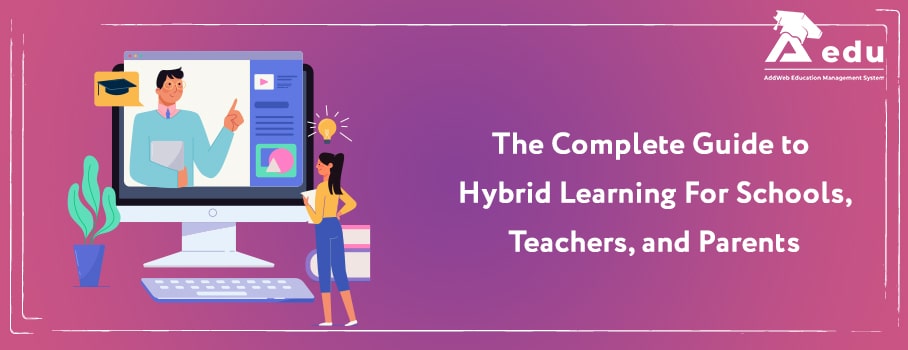Have you ever wondered how back to school will feel for your kids this academic year? While most educational institutes have adopted the distance learning model and gone digital using online class management tools, some are still working hard to offer students the right blend of learning. That’s where the concept of the hybrid learning model comes into the picture. It is an arrangement where students are required to attend school for specific days each week and engage in distance learning for the remaining duration with an online education system or school management app. At present, the hybrid learning model seems the best fit for both schools and students; it does have some grey shades to be taken care of. In this blog post, we’ll try to explore the fundamentals of hybrid learning and provide you with the ample information required to implement it in your school.
WHAT is Hybrid Learning???

Hybrid learning combines conventional classroom experience, experiential learning objectives, and an online education system into a single curriculum. The goal of hybrid learning is to provide a learning environment accessible to students on the go. Many people often mix it with blended learning, but it is different. In the hybrid learning model, teachers may instruct students in-person and remotely, considering the learning style and requirement of the individual student.
However, some asynchronous elements can be included in the hybrid learning model. That’s an innovative way to present hybrid classes where students can complete things at their convenience. For example, schools may incorporate pre-recorded videos, online assignments, discussions, quizzes, and more in hybrid learning that can be completed outside of class. Apart from this arrangement, some hybrid models often feature an approach where one group of students attend the class virtually, and the other attend the class in person.
How does it benefit students and schools?
If implemented correctly, the hybrid learning model could bring tons of benefits for the schools such as:
Brings classroom flexibility – One of the significant benefits of adopting hybrid learning is that it brings flexibility for the students to leverage online class management. There are chances that some students who may not attend the classes in-person, hybrid learning enables them to learn remotely. Moreover, students can manage their learning schedule, assignments and collaboration with teachers with the education management system’s help.
On the other hand, teachers can leverage flexible teaching models. This means students can explore more about various topics and leverage valuable face-to-face time with their tutor.
Enable synchronous communication and thought leadership – Combining the online education system with conventional teaching methods enables synchronous communication. Students are empowered to get benefits from the real-time engagement between students, teachers, and peers. Students manage to leverage whole-brain thinking to clarify key concepts from accessing online resources available in free school apps and pre-recorded videos to assignments.
Utilize resources efficiently – Since everything is available centrally and all the time, it becomes easy for the students and teachers to plan various resources required for each lesson. The students may get insights about what information and learning resources will need for a specific subject; they can plan and optimally utilize resources.
What could go wrong with the hybrid learning model?
There is a possibility that the hybrid learning model may create a few challenges for the working parents. Since the students tend to attend a traditional classroom for a whole day, working parents are fond of the all-day school environment. If students are required to attend only a few days each week, what will working parents do for the remaining day to ensure students study properly? The parents will be forced to leave their child with their own devices and affect their overall learning outcomes.
Implementation Strategy for hybrid learning
- Sort out course description, learning objectives, and goals.
- Find out different course assessment approaches.
- Define a realistic course path to make sure students will follow from start to end.
- Plan-out in-person activities that will flow with each learning medium.
- Make sure you have a list of online activities in place.
- Finalize your course syllabus and set a hybrid learning model accordingly to source course content.
What’s next?
That’s it for hybrid learning! To leverage the maximum from hybrid learning, you don’t have to be afraid of experimenting with knowledge. You can utilize online class management or a free school app like AEDU to define your learning plans and assessment. Such school management apps help you provide even mobile learning options and many other options to implement a hybrid learning model successfully.
Looking for a way to combine the online education system with conventional classroom teaching? Just visit AEDU to explore different ways it can help you with.


Leave a Reply
You must be logged in to post a comment.